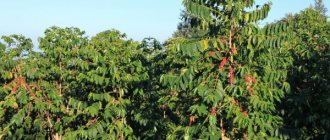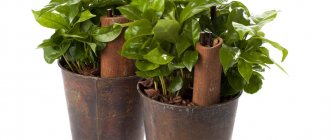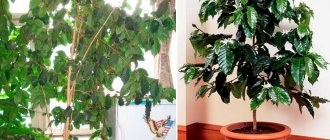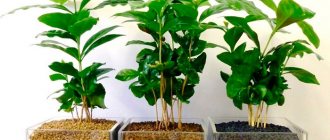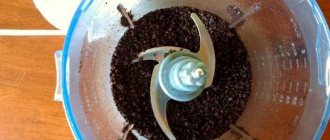Photo Coffee tree (Coffea) is a tree-like evergreen plant of the madder family, producing bright burgundy-colored fruits with seeds-grains . This is a rather tall shrub, reaching a length of 8-10 meters in natural conditions, with large, leathery, opposite leaves and white or cream-colored inflorescences. In cultivation, the tree is pruned to a height of 1.5-2.5 meters to facilitate maintenance and harvesting.
The homeland of the coffee tree is the tropics of Ethiopia. This species has an average development intensity with an increase of 5 to 10 cm per year. This is a perennial crop whose life expectancy depends on favorable climatic conditions. There are known specimens that continue to bear fruit even at a hundred years of age.
If you like to grow fruit plants at home, then watch how to grow a homemade banana.
| It has an average intensity of development with an increase of 5 to 10 cm per year. |
| Blooms from April to October. Next, edible fruits appear. Only an adult plant blooms and bears fruit - 3-4 years. |
| The plant is easy to grow. |
| Perennial. |
General information about the coffee tree
Ethiopia is considered the birthplace of coffee. The plant is an evergreen. The height of trees in natural conditions reaches 10 m, and on plantations - 2.5 m. The branches are shortened to facilitate care and harvesting.
For cultivation at home, plants up to 1 m high are used. Coffee blooms from mid-spring to mid-autumn.
Beneficial features
Grains contain vitamins:
- IN 1;
- AT 2;
- RR.
The seeds contain macro- and microelements:
- iron;
- potassium;
- phosphorus;
- sodium;
- calcium;
- magnesium.
The seeds contain iron, potassium and phosphorus.
Caffeine benefits the body. It relieves headaches. The substance tones the brain, having a stimulating effect. Caffeine helps with nervous exhaustion and increased fatigue.
Self-cultivation
Coffee grows (the photo shows adult dwarf varieties) at home in approximately the same way as in nature and does not create any special problems. The main thing is to follow the basic rules of care. In spring and summer, the plant is left at home and taken out to the balcony for the winter.
The photo shows how a coffee tree grows at home.
It is necessary to maintain air humidity above average, and during short sunny days equip with additional lighting.
The tree should be watered only with settled water. Twice a month you need to fertilize. Once every 3 years, the coffee tree is transferred to a larger pot. The plant must be protected from winds and drafts, avoid excessive watering, and in winter keep away from radiators and heating devices. For propagation, the method of growing from berries, seeds or cuttings is chosen.
Tree structure
You can recognize the plant in the photo by its spreading branches. The berries located on them resemble bunches of grapes.
Fruit
The oblong or spherical fruit is called a cherry. After flowering ends, ripening lasts up to 8 months.
The cherry turns a bright red color. It contains from 1 to 3 seeds. The size of the berry does not exceed 1.5 cm.
Root system
The structure of the root system is taproot. The depth of germination depends on the type of coffee. Robusta roots have a depth of no more than 2 m. Arabica grows at 2.5-3 m.
Flowers
The white flowers have a scent reminiscent of jasmine. The presence of male and female characteristics allows self-pollination. Inflorescences are arranged in bunches.
The flowers of the coffee tree have a strong aroma.
Crown
The height of the crown depends on the type of coffee. In the Congolese variety, it does not exceed 2 m. In Arabica, the crown height reaches 6 m. The branches of the tree are inclined to the ground.
Leaves
The leaves have a glossy surface. Their lifespan ranges from 3 to 5 years. The oval leaves reach 20 cm in length and 5 cm in width. The venation is pinnately uneven, reticulate.
Pruning and crown formation
Seedlings of coffee trees are suitable for growing in standard form. Seedlings obtained from cuttings, over time, if you do not form a standard, turn into a dense bush of a spherical shape.
Arabica coffee tree blooming
In the first year, the shoot grows straight upward; there is no need to pinch it. The tree begins to branch in the second year. If you want to form a trunk with a thick crown, you can make a constriction:
- the operation is carried out in late February - early March;
- when the central trunk grows to 25–30 cm, it is tied tightly with reinforced wire at a height of 15–20 cm, 1 cm below the internode;
- pinch the upper bud; if necessary, trim the shoot so that 2 internodes remain above the wire;
- subsequently, all branches above the constriction that grow upward are cut off. The remaining branches are trimmed to your liking to make the tree look aesthetically pleasing;
- after 3–4 years the constriction is loosened, and after a month it is removed. As a result, with a tree height of 50 cm, the crown diameter can reach 1.5 m.
Popular varieties
Scientists count more than 100 types of coffee. Plantation owners often cultivate Arabian and Congolese varieties. Hybrids of these varieties are also grown.
Arabian
The Arabian variety has become widespread. It blooms 2 times a year. Under natural conditions, Arabica reaches 7-8 m in height.
For home breeding, a dwarf variety is used, the height of which does not exceed 0.8 m.
Congolese
Congolese coffee is called Robusta, which means “strong”, “strong”. The variety is resistant to diseases and pests. Robusta is easy to care for and has high yields. The Congolese variety has a higher caffeine content. But its taste is lower than that of other varieties. Robusta is added to coffee blends.
Congolese coffee is easy to care for.
Liberian
The variety was discovered in Liberia. The first plantation appeared in 1864. Coffee was first planted in the Philippines. He was then transported to Indonesia. Here, the Liberian variety replaced the Arabica, which was destroyed by bad weather conditions. The grains have a strong aroma, but have a weak taste. For this reason they are used in mixtures. The caffeine content of the Liberian variety is reduced.
Classification
Types and varieties of coffee are different concepts. The first refers to the plants themselves (“mother”), which were used to create new trees with different characteristics. A variety is a hybrid obtained through selection. This concept is also used to refer to a product that is presented on the market.
| Main types of coffee | Description |
| Arabica | This type is not only the most common, but also considered the best. The coffee turns out very tasty, with a pleasant aroma. However, the tree is capricious and grows only in a warm, favorable climate. Can withstand slight temperature changes. Arabica beans are long, smooth, and have a low amount of caffeine. The drink is slightly sour. |
| Robusta | Beans of this type contain a large amount of caffeine, and the drink is bitter. Robusta is most often added to various mixtures to make them stronger. The grains are small, with a dividing groove and small spots. |
| Liberica | Rarely used for export. Coffee is most often consumed in the country where it is grown. The main plantations of this species are located in Africa. Liberica is not for everyone. This coffee has a slightly spicy and bitter taste. Therefore, the drink is rarely drunk in its pure form; it is often added to other mixtures. This gives them an unusual taste and pleasant aroma. |
| Excelsa | This is the rarest type of tree. It can grow up to 20 m. The grains are collected manually. This species has excellent taste and rich aroma. |
There are more than 30 dozen varieties of coffee. Their main difference is taste. Arabica and Brazilian coffee are in greatest demand.
Features of growing at home
When growing coffee at home, they pay attention not only to the frequency of watering, the quality of fertilizer, but also to the choice of location. The window sill is only suitable for seedlings. The growing tree needs to be transplanted into a tub. It is unacceptable to leave the pot near heating devices. The sun's rays should not fall on it.
Coffee does not tolerate movement well, so you need to move it away from its usual place gradually. For example, the potty is placed on a chair next to the window. It is left there for several days. Then the chair must be moved 2 steps. Here he remains for another 2-3 days, etc.
The first harvest should not be eaten or used for making drinks. It is advisable to use the seeds for growing trees.
The benefits and harms of coffee
Coffee is a wonderful, invigorating drink. It’s wonderful to wake up in the morning and feel its enchanting aroma.
What harm is there from coffee?
The debate about whether there is more benefit or harm in coffee has been going on ever since people learned about it. Some prove that coffee excites, increases muscle tone, stimulates physical activity, clarifies thoughts, and improves mood. And this list goes on and on.
Opponents of coffee claim that it increases blood pressure and cholesterol. However, it has been proven that if you pass the brewed drink through a paper filter or napkin, coffee becomes safe. A paper filter removes kahweol and cafestol from the drink, substances that increase cholesterol levels in the blood. Whether coffee is harmful or healthy is up to everyone to decide for themselves.
Important! If you decide to brew a cup of coffee from grown beans, remember that it will be much stronger and there will be more caffeine in such a drink.
As for the coffee tree in your home, we can safely say that it will only benefit you.
What are the benefits of coffee?
The plant cleanses the air well and saturates it with oxygen. Its beautiful appearance lifts your spirits, and by inhaling the aroma of flowers you can practice aromatherapy.
Planting a coffee tree
Coffee trees are suitable for spacious apartments and country houses. If several plants are in the same room, a distance of at least 1 m is established between plants.
Choosing a pot
The choice of pot depends on the diameter of the root system. Large containers should not be used. In such a pot, putrefactive processes and acidification of the soil are observed. The container in which the plant is planted should exceed the diameter of the root system by no more than 5 cm.
The size of the plant's root system affects the choice of pot.
Priming
Slightly acidic clay soil is suitable for coffee trees. It is advisable to purchase a ready-made substrate. You can prepare the soil yourself by mixing river sand, peat, humus and garden soil. The components are combined in equal proportions. The soil intended for planting azaleas and gardenias is also used as a substrate for coffee.
Placement nuances
The tropical origin of the plant does not mean that it must be placed in a south-facing window under the scorching sun. In excessively hot conditions, the tree runs the risk of not blooming. It is better to protect the plant from direct rays, but organize the lighting carefully.
If the location of the room faces north or west, then the flower is placed on the windowsill. In rooms facing south and east, the pot is removed from the window opening up to 1.5 m.
Be sure to remember that the coffee bush should not change its location. Turn the pot with the “pet” once every five years. To make the formation of the bush symmetrical, it is permissible to install a mirror next to the plant that will not reflect direct sunlight.
Plant care tips
Coffee is considered a capricious plant, sensitive to improper care. But if the necessary conditions are met, the tree bears fruit for many years.
Temperature
It is advisable that the temperature in the room where the seedlings are located does not exceed +25ºC. In winter, the thermometer should not fall below +12ºC. If the room temperature is above +25ºC, you need to ensure that the humidity does not fall below 65%.
Lighting
The plant is not a light-loving plant. The pot is placed on the north or west window. If a tree located in the shade does not bloom, it is worth moving it to a room facing the sunny side.
The coffee tree is not light-loving.
Watering
In the warm season, the tree is watered up to 3 times a week. In early spring, late autumn and winter, it is enough to moisten the soil once every 7 days. It is necessary to increase the frequency of watering at the first signs of wilting, which is indicated by dryness and yellowing of the leaves.
Feeding and fertilizer
Coffee requires several types of fertilizers. In spring, plants need nitrogen fertilizing. In the summer months, monosubstituted potassium phosphate should be added to the soil. In late autumn and winter, fertilizers are not applied. Watering during this period is reduced to once every 10 days.
Regardless of the time of year, the soil can be fertilized with citric acid. To prepare the fertilizer, dissolve 1 g of the substance in 1 liter of water. Citric acid can be used no more than once a month.
Transfer
Trees under 3 years old need replanting, which is carried out every year. Old soil and a small amount of fresh soil are poured into the pot. It is advisable to replant in the same place where the plant is permanently located. This will help coffee adapt to new conditions faster. After transplantation, the leaves are moistened with a spray bottle for 1-1.5 weeks.
Replantation is carried out every year.
Trimming
Standard trees do not need pruning. After shortening, the branches stop growing. If the owner intends to shape the crown, it is necessary to wait until the tree reaches a height of 0.5-0.7 m.
Possible problems
Due to lack of moisture, the edges of the leaves darken and dry out. Then you need to spray the plant again or turn on the humidifier. From excessive watering, the foliage turns yellow, rots and falls off. Therefore, you need to reduce the amount of moisture or moisten the soil less often.
Other options:
- When the crown begins to turn yellow, this may indicate the appearance of root rot. Replanting with root treatment is needed.
- Brown spots indicate nitrogen deficiency. It needs to be replenished with fertilizers.
- If the leaves of a young tree turn yellow, but green veins remain, this indicates low acidity of the soil. Then you can add sphagnum moss to it.
- When holes appear in the leaves, these can be burns. Especially if the tree is in direct sunlight. Then it needs to be moved to a shaded place.
- Leaves fall in winter due to insufficient lighting. You need to turn on an additional lamp for several hours.
- The tree will grow slowly if you do not fertilize it regularly. The situation can be corrected by providing fertilizing in the required quantity.
- Leaves have yellow spots and wrinkle. This is a sign of potassium deficiency or the result of watering with hard water. It is necessary to apply the necessary fertilizer and use only settled water for irrigation.
- To get rid of brown or purple spots that appear when there is a deficiency of phosphorus in the soil, you need to apply fertilizer or replant the tree in citrus soil.
- A young tree may have leaves that are light yellow and small if it lacks iron. It is necessary to add the necessary fertilizer to the soil.
- If the tree becomes sick after transplantation due to exposed roots, then the pot is placed under a plastic bag. Water only once a week and spray daily. Feeding is temporarily stopped. Every 4 days, spray with “Epin” (2 drops of the drug are needed for 0.2 liters of water).
Among the pests, a tree can be affected by spider mites, mealybugs, and scale insects. Then the plant is treated with insecticides.
The drug Fitoverm is usually used. Take 5 ml/0.5 l of water. The infected tree is sprayed twice, every 7-10 days.
If you are planning a trip, then in order to avoid the death of the tree, you need to prepare it. Remove all flowers and fruits so that it requires less moisture.
The tops of new shoots are pinched to stop their growth. Just before leaving, the tree is placed on a wet foam mat, which is first placed in a container of water. The drainage hole is loosely plugged with a piece of foam rubber.
If possible, you can buy it and connect it while the automatic watering device is unavailable.
Coffee grows both on plantations, in greenhouses, greenhouses, and at home (the photo shows dwarf trees). The plant is unpretentious in care. The main thing is to maintain temperature conditions, proper watering and fertilizing. At home, the tree rarely gets sick, and the risk of pest damage is reduced.
Is it possible to leave it while on vacation?
It is permissible to leave a houseplant without care during a business trip or vacation. However, the tree must be provided with a regular supply of moisture. You can buy a device for automatic watering. It will supply the soil with water for 14-20 days.
During the growing season, coffee requires more liquid. For this reason, it is worth removing the fruits and inflorescences.
An increase in moisture consumption is also observed during the growth of young shoots. To stop their development, you need to pinch the tops.
Kahwa drink - the “progenitor” of coffee
East Africa gave the world a cult drink. According to legend, this happened in the 800s AD. e. in Abyssinia (now Ethiopia). A goat herder from the city of Kaffa noticed a special interest of his four-legged charges in small mountain trees. After eating their leaves and colorful berries, the animals frolicked with unprecedented energy.
The Abyssinians quickly appreciated the energy tea, and the monks of the surrounding monasteries figured out how to dry and grind the berries. The fruits and drink received a name consonant with the city - Kahva.
By the 12th century, coffee culture had spread throughout the African continent and was later taken up by the Turks. It was they who came up with the brilliant idea in the 15th century to fry Kahwa grains over a fire and grind them into powder. Two centuries later, coffee from Egypt and Yemen came to Italy. The black drink created a sensation in the social salons of Venice, and soon its triumphal march began.
Interesting fact. The first coffee shops appeared in Venice. African Mocha was especially held in high esteem - coffee with an expressive aroma of dark chocolate and a tart taste. Opened in 1720, the coffee shop in Piazza San Marco delights visitors not only in the picture. The establishment operates today under the name “Florian”.
Reproduction methods
In addition to seeds, cuttings and the root system of coffee can be used for propagation. The first method is suitable for beginners. The second 2 are recommended for experienced gardeners.
Seeds
Fresh grains should be used. You can mix river sand with leaf soil. The soil must be sterilized. To do this, just keep it over steam for 15 minutes. Before planting, seeds are left in warm water for 2-2.5 hours. Then you need to make small cuts on them. This will soften the hard shell.
The coffee tree reproduces by seeds.
The seeds are only laid on the surface of the substrate. When buried in the ground they begin to rot. After planting, the seeds are watered and covered with plastic wrap. Ventilation is carried out 2-3 times a week. The film is removed for 2 hours. The first shoots sprout no earlier than after 6-8 weeks. Seedlings can be planted when the first leaves appear. Coffee will begin to bear fruit only after 3-4 years.
Vegetatively
For propagation, part of the root system is separated. It is necessary to choose a plant from 4-5 years old. Trees younger or older than this age may die when part of the root is separated. It is advisable to use this method in late autumn or early spring, when the movement of juices in the plant slows down. The detached part of the root is transplanted into a separate pot.
By cuttings
The length of the cuttings must be at least 8 cm. Each of them has 2 buds. The cuttings are planted in a container with loose soil, transferred to a warm room (with a temperature of 27ºC), and covered with plastic wrap. The soil is moistened with a spray bottle and ventilated daily for 2 hours. Replanting is possible when the coffee takes root.
The soil
The coffee tree likes acidic soil (pH in the range of 5–5.5). Acidity can be measured using litmus paper.
To obtain such a substrate, mix:
- 1 part peat;
- 2 parts river sand;
- 2 parts leaf soil;
- 4 parts manure humus;
- 4 parts of turf land;
- some finely chopped sphagnum moss.
Of the store-bought soil mixtures, the substrate for citrus fruits is ideal for a coffee tree.
Disease and pest control
Trees often suffer from pests such as mealybugs, sooty fungus, scale insects and spider mites. Poor quality care leads to illness. In coffee there are:
- Leaf rotting. The problem is caused by overwatering. But if the leaves turn yellow and dry, the amount of liquid should be increased.
- The appearance of brown spots. This sign indicates a lack of nitrogen or phosphorus in the soil.
- The appearance of holes in the leaves. If pests are absent, perforation indicates sunburn.
- Slow growth. It is worth increasing the amount of fertilizers. The reason for slow growth may be lack of lighting.
- Yellowing of leaves. The roots should be checked for rotting. If green veins remain on yellow leaves, the soil has low acidity.
Prevention methods
To prevent the appearance of parasites, it is necessary to monitor the humidity of the room. Avoid dryness and drafts. At the same time, you also need to be wary of excess moisture. If cobwebs or white coating appear on the leaves, remove them with a soft sponge and a weak soap solution. The fertilizer used must contain all the necessary components. It is necessary to monitor the quality of the soil.
How to choose the right seedling?
Where to begin? The most realistic thing is going to the store. You will be offered a great variety of copies. Take your time. Choosing and purchasing a coffee seedling is a responsible matter.
- Take a good look at the appearance of the plant:
- the color of the leaves should be bright green, without damage or spots;
- there should be a lot of leaves on the plant;
- absence of signs of diseases and insects.
- Read the variety label carefully:
- C. arabica is a true coffee tree and is grown as a houseplant;
- nana - smaller in size, but blooms more readily. More decorative.
- For transportation in the cold season or in windy weather, pack the seedling well so as not to damage it on the way home.
Buying a coffee tree in a store: what to look for
Arabian and Congolese varieties are more suitable for growing at home. It is advisable to buy mature coffee, the health of which can be assessed by the trunk. It is always thick and hard, but at the same time quite flexible. You need to pay attention to the leaves. They should be dark green, shiny, without visible damage.
A newly purchased tree must be isolated from other indoor plants for 3-4 weeks to avoid the transmission of parasites and diseases if present. Darkening or yellowing of leaves is not necessarily a sign of health problems. The cause of damage to greenery can be a change in environment or excess feeding.
Harvest Frequency
Coffee grows for the first 3-4 years after planting without flowering. Then the first ovaries appear (the photo shows how beautiful the flowering plantations are). But the fruits do not always ripen after the first flowering. More often the berries appear the second time.
The first full harvest can be obtained from a five-year-old tree. The fruits ripen from 8 to 11 months. The harvest is harvested once a year, but in the equatorial climate - three times. Maximum fruiting is observed from 8 to 16 years of tree life.
Coffee nursery: the first stages of cultivation
In nature, the “strongest” survive: tree sprouts are not protected. On farm plantations things are different. Coffee beans go through a processing stage and are planted in special bags for germination. The resulting sprouts are planted in greenhouse structures to ensure proper care. Some farmers use remote open soils - natural areas instead of greenhouses.
Seedlings reach the level of a young tree in 8-12 months. Then the tree is ready to continue life on the plantation. It is planted in an area that receives plenty of sunlight. Sometimes a place is chosen under the wide crowns of other plantings so that the leaves and flower ovaries do not get knocked down under heavy streams of rain.
How to grow from grain
Compared to growing from a cutting, it will take longer for a sprout to appear. It is necessary to purchase grains from a specialized store that sells exotic planting material of optimal quality. It is important to find fresh fruit that can be used for planting.
Important aspects:
- The seeds are soaked in a growth stimulator for 12–24 hours.
- Freshly picked coffee beans undergo scarification.
- The container for planting can be a plastic container or a pot.
- Purchase soil for citrus plants.
- Drainage (crushed stone, pebbles, small stones) is poured into the bottom of the flowerpot, then the substrate.
- The soil is moistened with warm, settled water.
- Sow the seeds, place the flat side on the ground and deepen it a little.
- Cover with a glass lid and cling film - set up a mini greenhouse.
- Place in a bright and warm place.
- Periodically check for germination.
- Ventilate the plant, removing any condensation that has formed.
- If necessary, moisten the soil.
- 20–30 days after the sprout appears, the film is removed. Plants that have stretched 50–70 mm need to be replanted. The first harvest will be in 2 or 3 years, subject to proper maintenance.
Seed preparation
Process steps:
- The seed is purchased in a specialized store, and after purchase it is prepared for planting and further growth.
- Coffee beans are soaked in a jar of warm filtered water for a day; only those that lie at the bottom and do not float up are taken for planting.
- If the fruits were picked directly from the coffee tree, then scarification is necessary.
- For better and faster germination, it is useful to treat seeds with growth stimulants.
- Prepare the soil: experienced gardeners recommend using a ready-made substrate.
- Do not forget to put drainage at the bottom of the container: crushed stone, pebbles, walnut shells.
- For planting, use settled water at a temperature of +30 C.
- The grains are placed on moist soil with the flat side and slightly deeper (1 cm).
- Cover with cling film and place the container in a room where there is enough light and heat.
- Regularly inspect the crops, ventilate them if necessary, remove condensation, and moisten the soil.
- After 1 month, shoots should appear.
Scarification
If the fruits were taken from a coffee tree, then it is necessary to carry out scarification for better germination. The point is to destroy the dense shell of the grain. A mechanical or chemical method is used.
Important processing details:
- Mechanical - damage to the outer layer using a grater, knife, or fork. The method is considered the best.
- Chemical - a weak solution of one of the acids is used: sulfuric or hydrochloric, but it is important to know the exact concentration according to the instructions, otherwise the planting material will deteriorate.
Priming
For planting, it is better to purchase a ready-made substrate from well-known manufacturers.
Basic soil requirements:
- Contains the necessary chemical elements.
- Corresponds to a certain pH level.
- It has a fairly loose consistency.
- The substrate must not be expired.
On a note! You can make your own soil mixture. To do this, you need to take: sand, garden soil, peat, humus in equal quantities, add a little wood ash.
Landing rules
Basic Rules:
- use the appropriate substrate;
- drainage (small pebbles or gravel) is placed at the bottom of the pot in a layer of 10–20 mm;
- for watering and spraying, take warm, settled water;
- Before planting, grains are soaked in water, scarified, and treated with a growth stimulant;
- cuttings sections are also kept in phytohormones;
- seeds are placed on moist soil, deepened 1 cm;
- the twig is stuck into the ground 2–3 cm;
- cover with a thin transparent film or a jar of the optimal size - this is a kind of greenhouse;
- put in a warm (+25°C), bright place;
- every 2–3 days they inspect, ventilate the greenhouse, remove condensation from the container;
- water and spray as necessary;
- After about a month, the plant is opened and the film is removed.
Place for a plant
For a young tree you need to choose the right permanent location. The plant is quite capricious in this regard. It loves consistency. Even a slight turn of the plant will cause the leaves of the coffee tree to fall off.
Coffee appreciates light and moisture. But exposure to direct ultraviolet light can cause burns. Therefore, the south side, when shaded with newsprint, can actually become an ideal option for coffee.
The north side will not spoil the tree, but it will grow very slowly and bloom late.
Flowering and ripening
The coffee tree blooms for a very short period of time - as soon as the rainy season begins. The flowers fade after pollination, so they last up to 2 days, but fill the plantation with the sweetish aroma of jasmine. The pleasant smell attracts bees - pollination occurs naturally.
The uniqueness of the process lies in the structure of the flowers. There are two types of coffee: Congolese (Robusta) and Arabian (Arabica). The latter has bisexual flowers with a stamen and pistil - the plant can be pollinated with the participation of bees, but self-pollination is also possible. To pollinate robusta, you will need two trees, since they are self-sterile, although bisexual. In this case, pollen transfer occurs with the help of wind and without the participation of bees.
